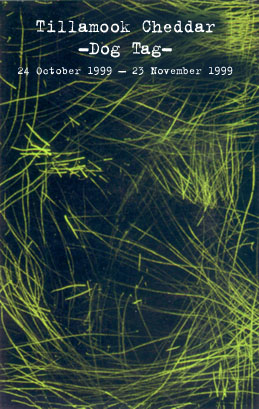
Tillamook Cheddar, Untitled No. 230,1999.
Yellow transfer paper on black board. 20" x 15".
Brooklyn, NY
|
Tillamook
Cheddar a.k.a. "Tillie"
DOG TAG
24 October - 23 November, 1999
teethovenstudio
Artist Statement
"If you dig something,
you just dig it." -Andy Warhol
Why do we dig? To reach the cool earth beneath the surface. To bury the
dead. To bury treasure, to search for buried treasure. To escape captivity.
To hide, to mark, to hunt. To explore; search; mine. To dig is to work.
When a dog digs a
hole, she is not destroying the earth, but displacing it, altering its
form to create something, in this case a void. An opening, an entrance.
Evidence of work. But how can the absence of matter signify creation?
Perhaps a dog in her subjugated status has no choice but to convey her
work in the negative. By appropriating the perceived nothingness of the
human world and re-presenting it as her own species' new ideal of signification,
she empowers herself in a powerless position. With the use of transfer
paper a dog is able to literally transfer her works into a tangible form.
Something for humans to hold and behold. A piece of work. Art.
Much of Tillie's work
is about layers. Specifically the process of discovering hidden layers.
One objective of the artist is to remove the layers of material covering
the meaning beneath. It is through documenting this process of removal
that the meaning is essentially created. Layers also speak as metaphors
for the barriers which he artist must overcome through the course of her
work. As a woman, and as a dog, Tillie is faced with myriad barriers.
While the obstacles that women artists face in their struggle to gain
the acceptance and respect of the mainstream art establishment are certainly
great, most human women still possess the means to explore creation on
their own terms. They have the luxury, if you will, to choose their medium,
to select their materials and to decide where and when they are willing
to show their work. Women likewise possess the voice to verbally articulate
their intentions, their vision. Tillie, as a woman and as a dog, is faced
with endless affronts and barriers to her artistic expression.
Up until this point
the art community has been closed to the forces of canine expression.
Today the world accepts Tillie as an important voice for her species and
our own. Still, the works are fraught with limitations, with barriers.
As a dog, lacks the wherewithal to select her medium, even to choose the
colors with which to work. She has little choice as to where and when
the creative process will take place. And she has virtually no say as
to where, when and to whom her work will be shown. These layers of limitations,
or barriers, can be likened to the barriers of tape and transfer paper
that separate Tillie from the raw canvas and the completed work itself.
But it is by confronting these barriers, and working through them, that
the finished piece is created. An artist is not always aware of the outcomes,
products, effects and side effects of specific methods, techniques, behaviors
and applications until after a work is done. Tillie often works in partial
or complete darkness. By working in darkness, underground, instinctively,
the dog reveals her natural inclinations to work, to root, to dig, to
destroy to create. It is through her art that Tillie is able to convey
a message of strength and struggle, work and play, that might otherwise
be lost to the world.
|





